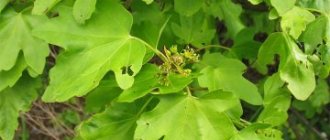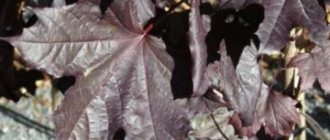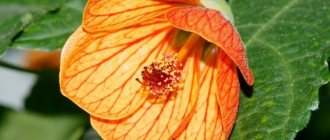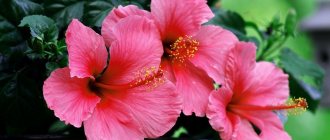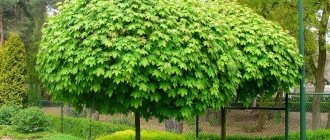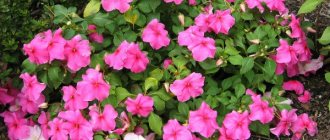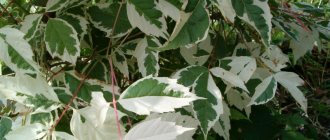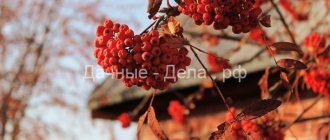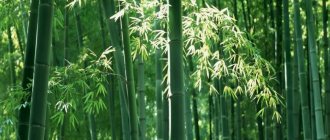Tatarian maple is particularly resistant to the changing vagaries of nature. It easily tolerates drought and is not afraid of prolonged rains, frosts and strong winds. Therefore, the crop is often planted in city squares and parks. However, this does not mean that the Tatarian maple will not take root on the territory of a country house. Let's take a closer look at this unique plant.
Tatarian maple - Acer tataricum
Tatarian maple, which is also commonly called black maple, is a large shrub or small tree. This plant reaches a height of approximately 12 meters. In the photo you can see the varieties of this plant. Tatarian maple has become widespread in the forest and steppe regions of Europe and other countries. In northern latitudes it extends to mixed forests. Black maple propagation is best in moist and shady soil.
Tatarian maple opens and blooms about 15 days earlier than many maples, but blooms later than other maples. Before blooming, it collects a huge amount of strength and offers a larger inflorescence, which consists of four scutes; due to the huge number of flowers, a certain part of the lionfish will be underdeveloped. This version of the plant is shown in the photo.
Tatarian maple is a tree that in most cases grows as a bush, which has a compact dense crown, from the maple genus, up to approximately 7 meters in height. Widespread in natural plantings in Europe. According to its own morphological characteristics, it is next to the Ginnala maple, which some botanists believe to be a type of tree such as the Tatarian maple in the photo. These two trees are distinguished by their foliage, which is found in the Ginnala maple, and some of the lobes are clearly expressed. The photo shows these two varieties of plants. The crown diameter is no larger than that of other varieties.
The description is as follows: the diameter of the crown is thin with a black color, it is smooth with a dark groove, and becomes cracked with age. The branchlets are thin, angular, smooth or slightly pubescent, red-brown, with a prominent leaf scar, and short. However, the description does not end there - the plant has wide, dark red-brown buds.
Tatarian maple has a big difference between different varieties, for example, the Ginnala variety. They have an ovoid or oblong-ovoid shape, with whole or slightly three-lobed ones, which reach dimensions of approximately 9 by 6 centimeters. Their color in autumn is light yellow and red. Tatarian maple, like the Ginnala variety, blooms after the ovoid leaves bloom, which reach a length of approximately 6 centimeters. Yellow sepals with white leaves and fragrant flowers approximately 6 mm in diameter can decorate the tree from May to June. At the same time, the Ginnala variety has become widespread in our country.
In the summer months, the plant pleases with its beautiful decorative form, during the ripening period the seeds are approximately 3.5 centimeters in length, which diverge under sharp corners with red-colored flowers. Their clusters retain their bright color for approximately 20 days. It bears fruit every year from the age of 8, and the fruits begin to ripen in September. By this period, lionfish begin to acquire a brown color. This plant grows very quickly in a garden plot with favorable soil; it is a frost-resistant and shade-tolerant plant that tolerates dry soil well.
At the same time, this maple is undemanding to the soil. Tolerates urban conditions well. This plant is winter-hardy. The plant lends itself well to pruning and holds its shape well. In a nursery, cuttings of such a maple can be grown for about 4 years. It can be created in the form of a bush or standard.
Consider the description of the Tatarian maple:
- Form: it is a small deciduous tree or a huge bush.
- The crown is ovoid or spherical.
- It grows very quickly.
- During the year it can grow up to 68 centimeters, and in height - 48 centimeters.
- Height is about 7 meters.
- The age reaches one hundred years, and in some cases it reaches the age of 300 years.
- The flowers are flat, round in shape and yellow-green in color.
- The leaves are elongated with patterns; in spring they turn green, and in autumn they turn red.
What methods are there for growing seeds?
Many types of maple are grown from seeds using this method. These include maples:
- American
- Japanese
- Norwegian
- large-leaved
- sugar.
Seeds that are not spoiled or rotten are selected, and dried ones are pre-soaked.
Thanks to this method, the seeds germinate quickly enough. For the seeds you will need a small plastic bag filled with growing material consisting of sand, peat moss or vermiculite or paper. To prevent fungus, it is advisable to have sterile material. To moisten, add a little water to the sowing mixture. And to prevent mold, you need to add just a little fungicide.
Next, the seeds are packaged in 25 pieces in a bag, which needs to be tediously ironed with the palm of your hand to remove air and closed with a zipper. The bags are placed in the refrigerator, where they are kept at a temperature of 1 to 4 degrees Celsius, which promotes germination. Some species are quite picky and a temperature difference of a couple of degrees will negatively affect the growth of seeds. For example, an American maple seed feels comfortable at +5 degrees, and red maple seeds need +3 degrees.
Most types of seeds are kept in the refrigerator for 3-4 months, but large-leaf maple needs 40 days. Every fourteen days, the bags should be checked for excess or lack of moisture, the presence of mold, etc. When growth begins, the seeds are removed from the refrigerator. Sprouted seeds are planted in moist soil to a depth of 1.5 cm. To ensure that the sprout takes root, the seeds can be planted temporarily in a tray.
Cold and warm stratification method
This method is well suited for mountain and Asian species with a very hard shell that requires treatment in the form of an incision, soaking in peroxide, and warm water. For two months, the seeds are stored at a temperature of 20 to 30 degrees. Next, the seeds are subjected to the above-described cold stratification method.
Growing maple seeds directly in the soil
In some types of maples, for example, silver maples, seed shedding occurs at the beginning of the growing season. These seeds do not hibernate and do not need additional care. You need to plant the seeds almost after collecting them and they will germinate quickly. Planting involves placing the seeds in moist soil mixed with fallen leaves without additional care.
Some seeds may not grow in the first year of planting, but will germinate only the next year. If a small percentage of seeds germinate, there is a chance that they have been spoiled. In this case, it is advisable to plant new ones.
A maple grown from seed can grow up to 30 meters tall.
Having decided on the desired type of maple, we purchase or find and collect the seeds ourselves; now growing maple from seeds at home will not be difficult for you.
Fortunately, our country has a large selection of varieties of this fabulous tree. The grown tree will delight you and then your grandchildren!
Application
Tatarian maple is used either in single plantings or in decorative groups and hedges.
The attitude of the plant to various growing conditions:
- to lighting: light-loving;
- to water: drought-resistant;
- to the ground: not demanding, but loves sandy ones;
- to temperature: frost-resistant.
Maple leaf color
This plant should be planted in open areas or in semi-shaded areas. Trees that have decorative leaf colors may lose their shade when planted in shady areas. The root collar is located at ground level. A tree that produces abundant root shoots that are slightly buried to a depth of about 4.5 centimeters. If groundwater is located at a short distance, drainage is needed, which consists of crushed stone with a layer of approximately 11 centimeters.
For the mixture, it is necessary to fertilize the soil with humus or peat compost, turf soil, sand in a ratio of 6:4:2. For field varieties, fertilizing with leaf soil, peat, and sand is required in a ratio of approximately 4:4:2. Complete mineral fertilizer can be added to the hole.
If fertilizers were not applied during planting, then in the spring of the next year after planting you need to apply:
- urea approximately 30 g/m. kv;
- potassium salt approximately 20 g/m. kv;
- superphosphate approximately 40 g/m. sq.
In summer, during loosening and watering, it is necessary to add Kemira in a proportion of approximately 110 g/m. sq. You can water the plant approximately 18 liters per planting. Many maples can tolerate dry soil but grow best when watered. Normal watering should be about 15 liters per planting once a week during the dry period. During normal rainfall, approximately 15 liters per planting once a month. You need to loosen the soil in which you are going to plant the plant shallowly, regularly, when weeding and after watering, so that the soil does not become compacted.
We grow Tatarian maple in the country
Various varieties of maple can be found in almost every city. The reason for the popularity of these amazing trees is their resistance to negative environmental factors and their beautiful appearance. Further in the article you will learn about one of the representatives of this family - the Tatarian maple (or black maple). We will get acquainted with a detailed description of this plant, a photo of what the tree itself looks like, its leaves, how it blooms and what maple fruits are like, and we will also get acquainted with the correct planting and care of it.
Features of the use of Tatar maple in landscape design
Tatarian maple is a deciduous tree that grows straight upward. Its appearance blends into the landscape but can be balanced by one or two finer or coarser trees or shrubs for an effective composition.
It is a relatively low-maintenance tree and is only pruned in the summer after the leaves have fully developed, as it "bleeds" sap if pruned in late winter or early spring. Does not have significant negative characteristics for human health.
Tartary maple is recommended for the following landscape applications:
- accentuation;
- mass planting;
- hill fortification;
- wind protection.
Tatarian maple leaves
Description and photo
In the wild, the Tatarian maple is widespread in forest-steppes, on the outskirts of forests and their edges, along river banks. It can be found in Russia, in the south of Western Europe, in the Balkan and Caucasian countries, in Asia Minor (Iran, Turkey).
The maple shown in the photo is a small tree or large shrub with red or dark brown shoots and a huge number of leaves.
It reaches a maximum height of 10m, with smooth dark, sometimes black, bark, its crown is broadly oval, which can easily be given the desired shape
The leaves are oblong, shaped like a trident or an egg, have “teeth” along the edges, the upper surface is bright green, the lower surface is pale green, and there is slight fluff along the veins.
In autumn, the leaves change greatly and take on a very impressive appearance, as they change their color to red or yellowish-red.
The plant also has a very specific appearance during flowering. During this period, the leaves grow strongly, and white inflorescences appear against their background. The tree retains such a breathtaking view for three weeks.
A special charm to the decorative appearance of the maple is brought by its fruits, the so-called lionfish or helicopters. Initially, these fruits are red in color, but over time they turn brown. What a maple fruit looks like can be clearly seen in the photo.
Black maple tolerates drought and frost very well, soils with a high salt content, and increased amounts of automobile exhaust, which is why it is often planted in large cities for landscaping.
It is planted singly or in groups, forming hedges. It is recommended to plant pine, birch, oak, and linden trees next to it.
Common types and varieties
Depending on the variety, the phytomorphology of the plant can differ radically.
Among the most common and spectacular representatives of the species are:
- "Ginnala" is a lush shrub with a tent-shaped crown. Less commonly – a low-growing standard, cone-shaped tree. Fragrant yellowish flowers are collected in paniculate inflorescences, which are observed after the leaf buds bloom. The life cycle is 250 years.
- “Hot Wings” is an ornamental tree with an oval crown and spectacular, wing-like wings, bright red leaves, to which the variety owes its name. Leathery green leaf blades acquire a scarlet color in the autumn season.
Growing conditions
Tatarian maple, unlike most of its counterparts, is undemanding to growing conditions. It is less demanding of soil, lighting and the constant presence of moisture, so it easily adapts even to urban conditions.
In winter, it does not require excessive care, as it is resistant to severe frosts.
Location and lighting
When choosing a place to plant black maple, give preference to open areas with sufficient lighting. If finding such an area is problematic, then the tree can be placed in a semi-shaded area - it will definitely not feel any worse.
However, for decorative deciduous subspecies, still choose the sunny side, since with a lack of rays, the quality of foliage color will deteriorate significantly.
Soil mixture
Fertile, loose soil is suitable for cultivation, the permissible acidity of which does not exceed 7.5 pH. The soil composition should contain sand, turf and humus in a ratio of 1:2:3. When planting, mineral supplements, such as nitroammophoska, can be added to the prepared hole within 150 g.
False sycamore maple, sycamore
Acer pseudoplatanus L.
In the Altai Territory, it freezes annually to the ground level and grows as a multi-stemmed bush, and even in this state it is very decorative.
Due to the fact that the seeds of the purple-leaved form of sycamore came to me already in January, when all the beds for winter sowing were filled, I had to resort to stratification of pre-soaked seeds. After 2 months, the seeds began to germinate in the refrigerator and were planted in individual cups. The photo shows that 1-2 weeks after the start of germination, the pink color characteristic of the form began to appear on the back of the leaves.
PK571 Shoots of the purple-leaved form of Acer pseudoplatanus L. after stratification in the refrigerator
By mid-July, the seedlings had grown and began to become lignified:
PK571 False sycamore maple - July of the first summer
Acer pseudoplatanus L.
Planting seedlings
As a rule, black maple is planted in the fall, after all the leaves have fallen, or in the spring before the leaves bloom. When seedlings are planted in groups, a distance of two to five meters is left between them.
The diameter of the planting hole should be about 80 cm, and the depth should be about half a meter. The maple root system grows more in breadth than in depth, so it is permissible to deepen the root neck by several centimeters.
If the area where you are going to plant a tree is subject to flooding, is swampy, or there is a high level of groundwater, drainage from sand, pebbles, screenings or crushed stone with a thickness of 10 cm to 20 cm is poured into the planting hole.
During planting, it would be a good idea to add rotted sawdust, manure or complex mineral fertilizers to the hole.
Tree care
The Tatarian maple needs careful care during the first time after planting and during periods of very severe drought. General care recommendations include timely pruning, watering, and, if necessary, fertilizing.
Watering and soil care
The plant needs regular watering after planting in the ground, the norm is about 20 liters per tree , the frequency of watering directly depends on the drying of the soil, but during the dry period this procedure must be repeated every week.
You can water adult bushes or trees infrequently, since black maple, like its other relatives, can grow without watering, however, for better growth it needs to be watered at least once a month.
Also, after planting, you need to often loosen the ground around the maple at a shallow depth and burn down weeds. After planting, it is recommended to mulch with a mixture of peat and soil from molehills.
Top dressing
As a rule, fertilizing the Tatarian maple is carried out provided that no fertilizers were applied during planting of the seedling. In this case, you need to fertilize next spring after planting the tree. The following fertilizers are suitable for this:
- urea - about 40 g per 1 m²;
- potassium salt - from 15 g to 25 g per 1 m²;
- superphosphates - from 30 g to 50 g per 1 m².
Reproduction
Maple reproduces in the following ways:
- seeds;
- cuttings;
- vaccination.
Propagation by seeds is a long and labor-intensive process. Seeds must be stratified before planting. Therefore, before planting them in the ground, the seeds are kept for two to three months in the refrigerator at a temperature no higher than five degrees. Then they are soaked in a solution of hydrogen peroxide for three days and only after that they are planted in the ground. The soil for seedlings must be prepared in advance. It should consist of three parts humus, two parts earth and one part sand. Seeds are planted at the end of April to a depth of four centimeters. In about twenty days the first shoots will appear. Young trees grow slowly; within a year their height will reach no more than eighty centimeters. Seedlings need to be looked after. They are watered regularly, the soil is fluffed up and protected from direct sunlight. You can replant after a year, but bushes are more viable at the age of three.
Decorative maples can also be propagated by cuttings. True, the percentage of their rooting is much lower than the germination of seeds.
Cuttings are carried out in late summer or early autumn. For this, cuttings about twenty-five centimeters long are prepared. The bottom cut is made at an angle. On the shoot prepared for rooting, two leaves are left, which are shortened by half. Before planting in the substrate, the cuttings are kept in a solution of a growth stimulator for 24 hours. Then they are planted in the ground to a depth of five centimeters. The soil for rooting should be light and moist. It is best to prepare a substrate from soil, peat and sand in a ratio of -3:2:1 and plant the cuttings in it. In the spring they are transplanted into fresh substrate.
Riverine maples reproduce well by root suckers. Which are dug up and transplanted to a new place in spring or autumn.
Grafting is another method of propagation that is typical for ornamental maples. It comes in two types:
- budding - grafting with a bud;
- copulation - grafting with cuttings.
Rootstocks are made for maples of the same type. The optimal time for vaccination is spring.
Maples are planted in spring and autumn. The distance between them must be at least four meters. When forming a hedge, you need to maintain a distance of one and a half meters.
The pit for planting should be loose, its bottom is well loosened with a sharp object, and then a drainage layer of broken brick and river sand up to twenty centimeters thick is laid out. The size of the landing pit itself must be at least sixty centimeters in depth and width. Also, in order for the seedlings to take root well and grow, mineral fertilizers are added to the hole before planting. The next year after planting, the trees are fed with urea, potassium salts and superphosphate.
Young maples need watering, especially in the first years of life. In the first months after planting, seedlings need abundant watering - up to thirty liters per plant. Once every two weeks. Then it is enough to water in a volume of fifteen liters once a month. It is recommended to cover young plants for the winter. To do this, the root collar needs to be covered with peat and covered with dry leaves.
Very often in the sultry heat there is a strong desire to hide in the shade of trees. And so, hiding from the summer heat, the question arises: what kind of tree is this that so hospitably accepted you into its arms? And often this tree is maple. What kind of flora is this, what features does it have and where does it live?
Maple belongs to the maple family, and it acquired this name due to its leaves with pointed blades. Translated from Latin, “acer” means “sharp.” Maple is a deciduous tree that can be found in any part of Europe. Russian forests are dominated by Norway maple (Acer platanoides). This species can also be grown in the countryside, since it is absolutely unpretentious.
Most maples prefer light “places of residence”, are very demanding on soil and moisture, grow quite quickly in the shade and are not susceptible to wind.
Since ancient times, the maple has been receiving the admiring glances of passers-by, and this is not surprising, because it has an original shape, bright and juicy coloring of leaves, especially in autumn, unusual fruits and inflorescences. That is why more and more people living in private homes are adding decorative elements such as maple trees to their garden design. Almost all types of maple are excellent honey plants and have been used for landscaping since the beginnings of the development of horticulture.
So, if you decide to plant a maple on your lawn, then you simply must know all the intricacies of planting and care, so as not to ruin this beautiful plant. And having done everything exactly according to the recommendations of experienced gardeners, you can be sure that the maple will delight the eye for many decades.
First you need to decide on the soil. In most cases, ordinary garden soil, well-cultivated and containing humus, will do. The proportions of soil mixtures depend solely on the selected species of the maple family. Planting is done in spring or autumn: the distance between trees is from 2 to 4 meters, and the depth of the planting hole varies up to 50 cm. Before planting a tree, mineral fertilizers should be added to the prepared hole in the specified proportions. It is also important to remember that maple trees must be placed in open areas or in partial shade, since trees with decoratively colored leaves fade and lose color saturation when planted in shade.
Note that maple can easily tolerate drought, but this is largely reflected in the colorfulness of its leaves, therefore, if the tree is planted for aesthetics, it needs to be watered regularly: approximately 15 - 20 liters per plant for the dry period. And if the maple is young, a double portion of water will not hurt. Watering should be done once a month in the autumn-spring period, and once a week in the summer. It is recommended to constantly monitor the soil, periodically perform shallow loosening after the next watering and weeding to avoid compaction of the planting area.
A tree, like an animal, requires constant care. Although maple is unpretentious, it is still worth paying more attention to it. Maple responds well to seasonal pruning, after which it begins to grow quickly and branch densely. It is necessary to remove dry and diseased branches.
The maple family is characterized by the following diseases and pests: coral spot, maple whitefly, maple mealybug and leaf weevil. When blotch disease occurs, some branches die and small burgundy spots appear on the bark. It is necessary to urgently remove the infected branches, and cover the cuts generously with garden varnish, while disinfecting all garden tools. For maple whitefly, the larvae are sprayed with ammophos and dry branches and leaves are burned. A good prevention against maple mealybug is considered to be spraying with 3% nitrafen before buds open. When maple leaf weevil is detected, trees are treated with chlorophos.
The dormant period of the maple lasts from the first cold snap until the arrival of spring. In winter, fragile plants should be protected from frost by wrapping them in spruce branches near the root collar. With age, their frost resistance will increase significantly and such measures will not be necessary. During early frosts, annual shoots need to be cut off. The crown is capable of self-regeneration due to new shoots that manage to grow stronger before the onset of frost.
Maples are propagated in different ways: by grafting, cuttings or seeds. Planting maple from seeds is very effective.
Maple is considered a universal tree with which there is no particular hassle. It grows quietly alone, as a hedge and as part of a decorative composition in combination with coniferous trees. The tree carries a positive charge and calm energy, which is especially loved by both true gardeners and ordinary people.
Maple is considered one of the most beautiful trees. Poets sang about it, painters wrote about it, and an image of its carved leaf is on the flag of Canada. Amazingly beautiful maple leaves of different colors delight the eyes of passers-by.
red leaf maple
Different maple species reproduce in different ways. This can be cuttings or grafting, seeds. Maple seeds ripen in August, and they begin to fall to the ground with the onset of autumn. Those who want to grow a maple tree with their own hands need to collect them by finding them among the fallen leaves.
The maple seed looks like a double flat lionfish with a pair of wings. The fruit itself consists of two parts, where each seed is bare and contains a large green embryo.
Today there are about 150 species of maples, most of which are native to North America. Maple feels good both in tropical areas and in northern regions. Maple seeds are planted both in spring and autumn.
To plant them in the spring, they are prepared in the fall, creating an artificial winter for them by placing them in the refrigerator in a container with wet sand. Under these conditions, the seeds can be stored for up to two years. With the onset of spring, from April to May, the seed can be planted in the ground. Before planting, it is recommended to soak them in peroxide for two days, so they will germinate faster, in about three weeks.
When planting in autumn, choose a place on the site that is quiet and sunny, dig a hole 70 cm deep and 50 cm wide. A sand-peat mixture mixed with soil from digging is introduced into this hole. The seeds are planted to a depth of four cm and with their wings up.
The seedling grows slowly; at one year of age the tree can reach a height of 80 cm. The seedling requires good watering. A handsome tree grown from a seed will create excellent shade with its chic crown and a place to rest, and the seeds and leaves will help in the treatment of kidney diseases and colic, bronchitis and herpes, etc. Maple has positive energy, and growing it from a seed is a long-term investment for descendants.
Sugar maple
According to biologists, for normal growth, maple seeds for planting must be taken either local or from a similar climate, planted in light loamy soil, watered and protected from the north wind.
Diseases and pests
The most common maple disease is coral spot. With this disease, small reddish spots form on the bark, and entire branches can die because of it.
Infected branches must be removed immediately, and the cut area must be treated with activated carbon or garden varnish.
A disease such as powdery mildew also occurs. In order to get rid of it, the tree can be sprayed with fungicides; Topaz, Vitaros, and Fundazol are considered the most effective.
Diluted drugs cannot be stored, so treatment must be carried out immediately. But the plant can be cured without resorting to chemicals. A solution with soap and soda works well.
To prepare it, you need to dissolve 5 g of ordinary baking soda and a little shavings of simple soap in one liter of water, which acts as glue.
The maple should be sprayed so that the solution gets on both sides of the leaves; the procedure can be repeated no earlier than three days later.
The most common pests that attack the plant are whitefly, mealybug and leaf weevil. In order to get rid of whiteflies, black maple needs to be sprayed with Actellik 0.1%, chlorophos 0.15% or Ammophos.
You also need to burn all fallen leaves. Treatment with Nitrafen 3% and Karbofos 0.1% will help against mealybugs.
If you find a weevil, you need to spray the plant with 0.3% Chlorophos and treat the soil around it with 7% Chlorophos.
Wintering the plant
From the above, we see that maple does not require special conditions for planting or excessive care. However, shortly before the onset of winter cold, young maple trees in the first few years must be covered using fallen dry leaves or spruce branches (branches of spruce trees).
You can also use burlap, wrapping it around the trunk in a couple of layers. The main thing is to protect the root collar from frost. If young shoots are still damaged and die, then it is better to prune them.
In the spring, the tree will give growth, and the crown will resume due to new shoots, which will have time to become lignified before the onset of the next winter period. Over time, the maple becomes more resistant to low temperatures, and then the need for shelter disappears.
Beneficial features
Black maple is a plant that contains a large amount of vitamins, minerals and enzymes in its leaves, bark and juice. Therefore, it has been widely used in folk medicine and cosmetology.
Maple syrup is made from the sap of the tree, which is rich in vitamins B, C, antioxidants, mineral salts and fructose.
This drink improves metabolic processes in the body, helps with obesity, restores pancreatic function, strengthens the cardiovascular system, and has a wound-healing effect. It is even prescribed to cancer patients.
Tatarian maple is considered a good honey plant. Honey from it turns out to be medicinal: it helps with chronic diseases, restores immunity, and improves the functioning of organs.
It is also used for cosmetic purposes, namely added to baths, masks and lotions. By regularly using such cosmetics, you can achieve skin restoration and rejuvenation.
The bark of this plant is also harvested. In the spring, it is carefully cut into narrow strips, dried in the sun and crushed. The leaves and fruits, from which healing decoctions and tinctures are obtained, also have medicinal properties.
They treat inflammation, fight scurvy and jaundice. Fresh leaves and bark powder can heal not only wounds, but also trophic ulcers.
A collection of leaves, bark and dried fruits is used in the complex treatment of pulmonary tuberculosis, bronchitis, hepatitis, and problems of the urolithiasis system.
Having read in detail the description and photo of what black maple looks like and how maple blooms, we were convinced that it is not only a beautiful, but also an unpretentious plant that tolerates both heat and cold, it can be planted singly or created as a hedge.
But besides this, black maple has many beneficial properties and can be used in folk medicine.
General information
Forest-steppe zones are considered the main habitat of wild Tatarian maple growth. Black maple can be found in Central Asia, the Balkans, Europe, and almost throughout the entire territory of the Russian Federation.
Most often, the Tatarian maple grows either as a small tree up to 10 meters in height, or as a wide shrub with a huge number of feathery leaves. In some species: yellow maple and globe maple, they are oval with a jagged edge, in others they are more round, similar to an egg.
The color may also vary: from soft green to rich green. But this is only in the spring and summer. In autumn, black maple amazes with the variety of colors of its leaves. The Tatarian maple is no less beautiful during the flowering period. Then white inflorescences with small flowers collected in clusters appear on the abundant foliage.
By the way, maple is an excellent honey plant. And the plant retains this beautiful appearance in the spring for more than three weeks. By mid-summer, instead of delicate flowers, lionfish fruits appear, which are also decorative, arranged in clusters. They are often called helicopters. Seeds with a sail, fastened in pairs as they ripen, are carried by the wind over very long distances.
Later they are carried by the wind, which provides the maple with a very large growing area. The lionfish themselves give the plant a very elegant look. Especially in autumn, when they acquire a red-brown color.
General information about maples
Maple previously belonged to the Maple family, now it is usually classified as a member of the Sapindaceae family. As can be seen in the photographs, this culture comes in two forms: tree and shrub. The habitat is all of Europe and Asia. The plant can also be found in the USA and Canada.
Some specimens live exclusively in tropical climates, for example, laurel maple. In our country, maples are widespread.
Today, the existence of more than 15 dozen species of maple is known. In Russia you can see only a small part - approximately 20 -25 species. These trees rarely form full-fledged forest stands. Most often they grow in groups or singly.
Planting Tatarian maple
Black maple must be planted in a mixture of sand, turf and humus and nitrate fertilizers are required. Most often, Tatarian maple is planted in the first cool days of autumn, when the leaves have already fallen. This planting is also suitable for Norway maple.
But planting is also possible in early spring, but before the buds open. But then the soil will still be too cold. Therefore, it is better to prepare the place in the fall.
When planting hedges, black maple can be planted at a distance of 2-5 meters. Later, this distance will be quite enough to form a beautiful interweaving of branches into a dense, almost impenetrable wall of living greenery.
The depth of the planting hole in waterlogged or overly wet soils should be covered with pebbles or gravel for drainage. It must be taken into account that the root system of black maple is wider than it is deep. It is good to add sawdust or compost or humus to the hole when planting shrubs. These components will significantly accelerate the growth of trees.
Despite its unpretentiousness in adulthood, immediately after planting, the Tatarian maple really needs regular watering. You need to pour at least 20 liters of water per seedling daily. Carefully monitor the drying of the soil around the tree. In addition, it is necessary to regularly loosen the soil, allowing air to reach the roots, and remove weeds.
Fertilizer and feeding of black maple
If, when planting a black maple hedge, for some reason you did not add a number of necessary fertilizers and minerals, then you should add the necessary complex of fertilizers later during watering.
Therefore, sanitary pruning is carried out regularly, removing not only old broken branches, but also those that simply deviate from the general format. Black maple is an excellent plant for hedges and group plantings.
